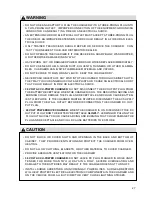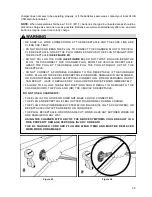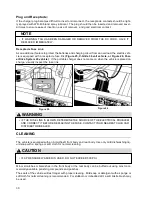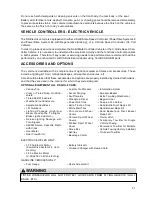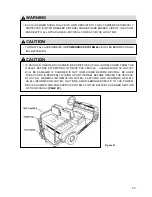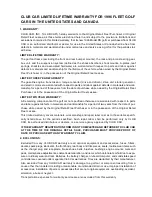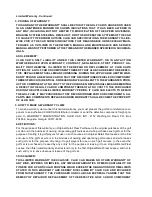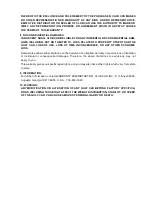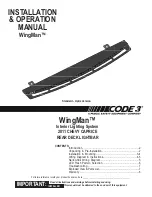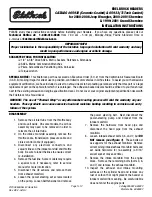
Batteries - Electric Vehicles, Continued:
Automotive batteries should never be used. New batteries will not deliver their full capabilities until they
have been discharged and recharged 20 to 50 times. To obtain the maximum service life from new bat-
teries, restrict vehicle with new batteries to 36 holes of use between charges in the first two months of
operation. Batteries should be fully charged before first use of new vehicle, and before releasing vehi-
cle for use each day.
B a t t e ry Care:
To keep batteries in good working condition, follow this maintenance program on a regular basis:
1 . The batteries should be clean and free of corrosion. Wash tops and terminals of batteries with a
solution of baking soda and water. Rinse solution off batteries (NOTE: Do not allow this solution
to enter the battery). Be sure terminals are tight. Let the terminals dry and then spray them with
CLUB CAR battery protector spray (Part No. 1014305).
2 . The water level in the batteries should be checked weekly (See Figure 22, Page 25, for proper
l e v e l ). Add water only after charging unless the water level is below the top of the plates. In this
case, add just enough water to cover the plates, charge and then check the level again. Never
charge batteries if plates are exposed above water level. For best battery life, add only distilled
w a t e r .
3 . The hold-down straps should be tight enough so that the batteries do not move while the vehicle
is in motion, but not so tight as to crack or buckle the battery case. Torque hold-down retaining
nuts to 15-25 in.lbs. (1.7/2.8 N-m). The terminal connections should be clean and tight, and any
worn insulation or frayed wires should be replaced. Torque battery terminals to 90-100 in.lbs.
(10/11.3 N-m).
4 . After use, the batteries should be placed on charge. The batteries should never be left discharged
any longer than absolutely necessary (do not leave discharged overnight).
BAT T E RY CHARGER - ELECTRIC VEHICLE
2 6
C AU T I O N
• IF BATTERY WIRE TERMINALS ARE DAMAGED OR CORRODED, THEY SHOULD BE
REPLACED OR CLEANED AS NECESSARY. FAILURE TO DO SO MAY CAUSE THEM TO
OVERHEAT DURING OPERATION.
DA N G E R
• BATTERIES EMIT HYDROGEN WHILE BEING CHARGED. HYDROGEN IS AN EXPLO-
SIVE GAS. IF THE VEHICLE IS EQUIPPED WITH A WEATHERPROOF ENCLOSURE, IT
SHOULD BE UNZIPPED AND PULLED BACK WHILE BATTERIES ARE BEING CHARGED.
THIS IS TO AVOID ACCUMULATION OF HYDROGEN GAS INSIDE ENCLOSURE.
• CHARGING AREAS MUST BE VENTILATED. THE TOTAL VOLUME OF AIR IN THE BUILD-
ING MUST BE CHANGED FIVE (5) TIMES PER HOUR. EXHAUST FANS SHOULD BE
LOCATED AT THE HIGHEST POINT OF THE ROOF. CONTACT A LOCAL HVAC ENGINEER.
WA R N I N G
• EACH CHARGER SHOULD HAVE ITS OWN DEDICATED 15 OR 20 AMPERE SEPARATELY
PROTECTED (CIRCUIT BREAKER OR FUSE) SINGLE PHASE BRANCH CIRCUIT, IN ACCOR-
DANCE WITH ALL APPLICABLE ELECTRICAL CODES FOR THE LOCATION.
Содержание Gasoline/Electric DS Golf Car 1996
Страница 1: ......
Страница 8: ......
Страница 11: ...3 DS GASOLINE VEHICLE FEATURE IDENTIFICATION ...
Страница 12: ...4 DS ELECTRIC VEHICLE FEATURE IDENTIFICATION ...
Страница 42: ...34 VEHICLE SPECIFICATIONS ...
Страница 46: ......
Страница 47: ......
Страница 48: ......
















